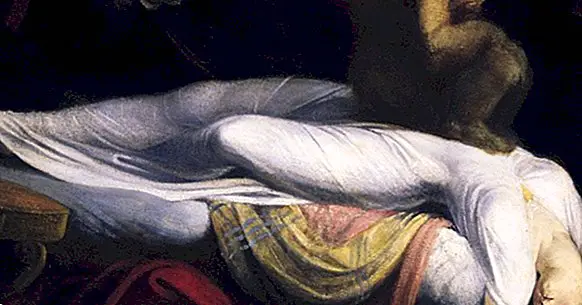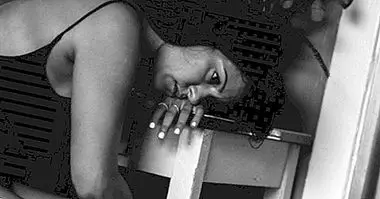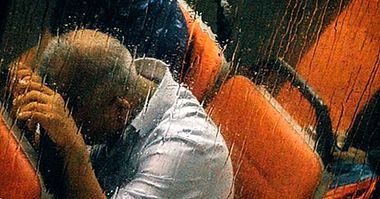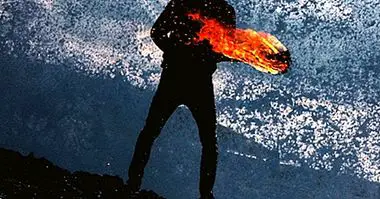Sleep paralysis: definition, symptoms and causes
At the end of the 18th century, the painter Johan Heinrich Füssli He finished one of his most emblematic works.
The painting, based on a painting by Giulio Romano, shows a sleeping woman who has a demon sitting on her belly while the head of a horse appears among the fabrics that form the background for the scene. It produced a quite common sleep disorder: sleep paralysis .
What is sleep paralysis?
The oneiric and dark ambience of this work called The nightmare makes the picture a perfect illustration of what could be one of the beasts of medieval European mythology: the incubus , a demon that is associated with the world of nightmares and that supposedly has sexual relations with women who, being between sleep and wakefulness, lie motionless without being able to do anything.
Today, some researchers believe that the mythology behind the figure of the incubus and its feminine alter ego, the succubus, is in fact a supernatural interpretation of a sleep disorder perfectly documented scientifically.
This disorder is called sleep paralysis , and the picture of Füssli expresses very well the sensations that are experienced while this curious phenomenon occurs.

What happen? symptom
The name of the sleep paralysis is quite descriptive: is a sleep disorder in which the person is unable to perform any voluntary movement . This means that, for a short period of time, someone who experiences sleep paralysis will go through a state of consciousness between sleep and wakefulness and will only be able to see what is happening around them, without being able to perform practically any physical action. You will be able to perceive what is happening around you in the place where you have laid to rest, but you will not be able to move or ask for help.
Of course, sleep paralysis does not affect vital functions such as breathing and heartbeat, since these movements are involuntary. However, that does not mean it is a very unpleasant and generating anxiety.
In addition, it is common to have the feeling of suffocation or having difficulty breathing, but it is only a consequence of not being able to consciously control the muscles, and there is no real risk of drowning.
Sleep paralysis can occur with other factors of a subjective nature, such as hallucinations or the sensation of having strange or threatening presences nearby that stalk the paralyzed person. This is mainly due to the fact that it appears in a phase of transition between sleep and wakefulness.
Common causes
In general terms, sleep paralysis is due to a lack of coordination between some areas of the brain and the part of the nervous system responsible for sending orders to the muscles which can be controlled voluntarily. This means that, although the person has regained consciousness and has awakened, their muscles are still not "connected" to the brain, because they remain in the inert state that occurs during the REM phase of sleep, while we dream.
During the REM phase , the fact of having the muscles isolated from what happens in our consciousness is useful, because otherwise we would move in body in function of everything that happens in our dreams.
However, this utility disappears in cases of sleep paralysis and the mechanism responsible for separating muscles and consciousness turns against us. Luckily, this is solved in a short time, usually after a few seconds. In any case, when this phenomenon appears in a state of transition between wakefulness and sleep, the perception of time could be somewhat altered.
Who can this happen to?
The different studies on the prevalence of sleep paralysis indicate that they are rare cases taking into account the number of times a person is put to sleep throughout their life, but the number of people who will experience this parasomnia at some point of his life could be a majority. In particular, approximately 60% of the population could go through a sleep paralysis .
However, the negative effects of sleep paralysis are found in the subjectivity and sensations experienced by the person experiencing it, so the fact of having read something about this disorder could make this situation more bearable.
In any case, the fundamental thing is that although sleep paralysis is usually experienced in an unpleasant way, in normal situations it is not a source of danger, nor does it lead to suffocation, although sometimes the lack of control over one's movements generates that fear to stop breathing (automated process by the nervous system itself and that does not depend on voluntary acts).
Bibliographic references:
- American Sleep Disorders Association. International Classification of Sleep Disorders: Diagnostic and Coding Manual, In Press. 1990.
- Teculescu, D.B .; Mauffret-Stephan, E., Gaultier, C .: Familial predisposition to snoring. (Letter) Thorax, 1994.



















